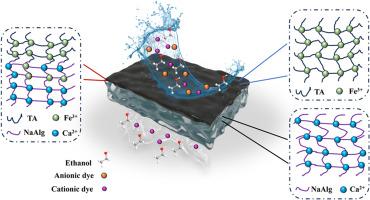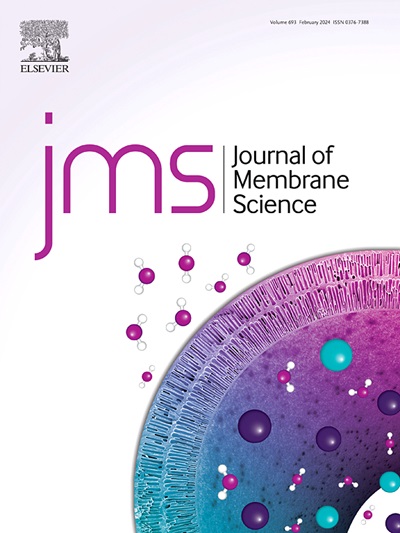用于有机溶剂纳滤的带有单宁酸/铁离子分离层的凝胶复合膜
IF 8.4
1区 工程技术
Q1 ENGINEERING, CHEMICAL
引用次数: 0
摘要
为了解决有机溶剂纳滤膜(OSN)的渗透性-选择性权衡问题,研究人员通过在自支撑海藻酸钙(CaAlg)凝胶膜表面络合单宁酸(TA)和铁离子(Fe3+),制备了一种凝胶复合膜。CaAlg 基质的三维网络可作为快速传输溶剂的通道,而致密的 TA/Fe3+ 金属酚网络可实现溶质排斥。研究人员对 CaAlg 基质和凝胶复合膜的化学结构、形态、孔径、Zeta 电位和机械性能进行了表征。对染料/溶剂分离和耐溶剂性进行了研究。结果表明,TA/Fe3+ 分离层缩小了孔径,增加了负电荷,并改善了凝胶膜的机械性能。通过优化 TA/Fe3+ 复合条件,凝胶复合膜的乙醇渗透率达到 19.5 L m-2 h-1 bar-1,刚果红(CR)剔除率达到 99.0%,并且在 N,N-二甲基甲酰胺(DMF)中浸泡 60 d 后分离性能几乎保持不变。此外,复合膜还能分离 DMF 和丙酮中的刚果红,以及乙醇中的阳离子和阴离子染料。这项工作提供了一种简单而环保的方法来制备具有高溶剂渗透性和苛刻溶剂稳定性的 OSN 膜,有望用于溶剂净化和回收。本文章由计算机程序翻译,如有差异,请以英文原文为准。

Gel composite membrane with tannic acid/ferric ion separation layer for organic solvent nanofiltration
To address the permeability-selectivity trade-off of organic solvent nanofiltration (OSN) membranes, a gel composite membrane was fabricated by the complexation of tannic acid (TA) and ferric ions (Fe3+) on the surface of self-supported calcium alginate (CaAlg) gel membrane. The three-dimensional network of the CaAlg substrate serves as a channel for rapid solvent transport, while the dense TA/Fe3+ metal-phenol network achieves solute rejection. The chemical structure, morphology, pore size, zeta potential and mechanical properties of the CaAlg substrate and the gel composite membrane were characterized. Dye/solvent separation and solvent resistance were investigated. The results indicate that the TA/Fe3+ separation layer reduces the pore size, increases the negative charge and improves the mechanical properties of the gel membrane. By optimizing the TA/Fe3+ complexation conditions, the gel composite membrane has an ethanol permeance of 19.5 L m−2 h−1 bar−1 and a congo red (CR) rejection of 99.0 %, and the separation performance is almost unchanged during 60 d of immersion in N, N-dimethlformamide (DMF). In addition, the composite membrane could separate CR from DMF and acetone, as well as cationic and anionic dyes in ethanol. This work provides a simple and environmentally friendly method to prepare an OSN membrane with high solvent permeance and harsh solvent stability, which is promising for solvent purification and recovery.
求助全文
通过发布文献求助,成功后即可免费获取论文全文。
去求助
来源期刊

Journal of Membrane Science
工程技术-高分子科学
CiteScore
17.10
自引率
17.90%
发文量
1031
审稿时长
2.5 months
期刊介绍:
The Journal of Membrane Science is a publication that focuses on membrane systems and is aimed at academic and industrial chemists, chemical engineers, materials scientists, and membranologists. It publishes original research and reviews on various aspects of membrane transport, membrane formation/structure, fouling, module/process design, and processes/applications. The journal primarily focuses on the structure, function, and performance of non-biological membranes but also includes papers that relate to biological membranes. The Journal of Membrane Science publishes Full Text Papers, State-of-the-Art Reviews, Letters to the Editor, and Perspectives.
 求助内容:
求助内容: 应助结果提醒方式:
应助结果提醒方式:


